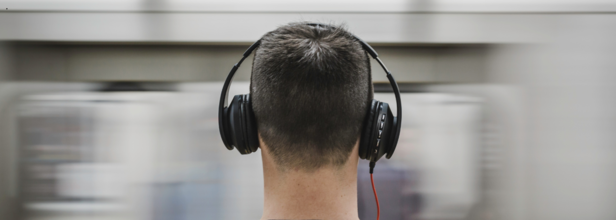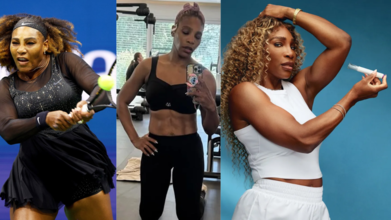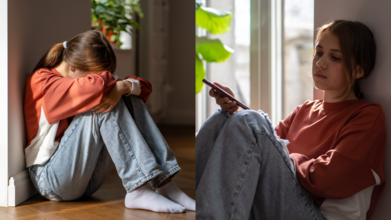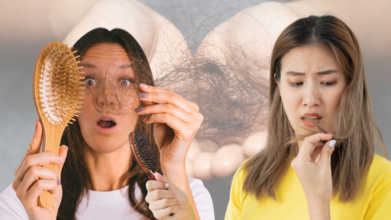- Health Conditions A-Z
- Health & Wellness
- Nutrition
- Fitness
- Health News
- Ayurveda
- Videos
- Medicine A-Z
- Parenting
- Web Stories
Feeling Lost In A Noisy Crowd? Your Noise-Cancelling Headphones Might Be To Blame

Credits: Canva
From the steady beeping in the supermarkets to the hiss of a coffee machine, our brains are always processing some sort of sound every day. However, for some people noticing these background sounds, even though, not too loud, could be overwhelming, and it can make it difficult for them to distinguish voices and the important alerts.
This happens in people with Auditory Processing Disorder or APD. This is a condition where your brain struggles to interpret and process sounds efficiently. Audiologists are also questioning whether it is because of the excessive use of noise-cancelling headphones, which has led to more cases of people with APD.
What happens in APD?
APD can make it difficult for people to focus on a specific sound, especially when they are in a noisy environment like a supermarket or a coffee shop. For them, everything sounds the same and this is why it becomes difficult for them to differentiate between the passing by sound and the important alerts. Some people also describe it as knowing a sound is there but being unable to process it quickly enough. This can affect everyday life and also make them feel lost in public spaces.
The most common cases of APD happen in people with neurodiversity, people who have a history of brain injury, or people who have had some sort of childhood ear infection. However, audiologists are now also seeing environmental influences to be the reason for APD, and one of the most common external influences is noise-cancelling headphones.
What role do noise-cancelling headphones play in APD?
Noise-cancelling headphones have gained popularity for their ability to block out unwanted sounds, allowing users to focus on music, calls, or silence. They can be beneficial for protecting hearing, especially in noisy environments. However, some experts suggest that prolonged use might affect the brain’s ability to filter out background noise naturally.
Research has found that the brain develops complex listening skills well into the late teens. Constantly using noise-cancelling technology may limit exposure to everyday sounds, potentially delaying or weakening this natural ability.
This is mostly a growing concern among young people. The NHS audiology departments in the UK have reported an increase in referrals for hearing issues that turned out to be APD rather than hearing loss mostly in young people.
A 2024 UK-wide survey found that only 4% of audiologists consider themselves well-informed on APD, highlighting a lack of awareness and resources for diagnosis and treatment. With limited NHS services available, many individuals seeking help face long waiting lists, with only one specialist centre in England offering full APD assessments for adults.
By constantly blocking out background noise, some experts believe we could be training our brains to process sound differently. Everyday sounds, such as traffic noise or distant conversations, help the brain prioritize and filter information. Without this practice, some individuals may struggle when exposed to complex sound environments, such as busy streets or crowded restaurants.
It is interesting to note that even subtitling has also become more common even with those who do not have any hearing issues. A survey found that 61% of young adults preferred to watch TV with subtitles, this further suggests a change in the way we are changing our listening habits.
Serena Williams Opens Up About Losing 31 lbs With GLP-1 Medication; Is This Breaking Stigma Or Joining The Trend?

Credits: Instagram/Ro
Serena Williams has built her career on grit, discipline, and an almost unmatched dominance in professional tennis. But behind her 23 Grand Slam titles lies a very different struggle, one she has chosen to share publicly for the first time: her battle with postpartum weight gain.
Now 43, Williams has revealed that she turned to GLP-1 medications, a class of injectable drugs originally designed for diabetes, to help her lose more than 31 pounds after giving birth to her second daughter in 2023. The admission has sparked both praise and debate, highlighting the growing cultural conversation around weight loss drugs.
Williams has spoken candidly about the physical challenges she faced after giving birth to her first daughter, Alexis Olympia, in 2017. Despite maintaining an elite athlete’s lifestyle, she noticed changes that resisted even the most disciplined training.
“I could never reach the weight I needed, no matter what I did, no matter how much I exercised,” she explained. “It was crazy because I had never been in a situation where I worked so hard, ate so healthily, and still couldn’t reach my desired weight.”
The experience deepened after the birth of her second child, Adira, in 2023. Despite her efforts—running, walking, and even incorporating professional-level workouts—her body seemed unwilling to return to its pre-pregnancy state.
For an athlete defined by relentless effort, the frustration was profound. “I’ve never taken shortcuts in my career and I’ve always worked very hard. I know what it takes to be the best,” Williams said. “It was very frustrating to do the same thing over and over again and never be able to change the number on the scale.”
Determined to explore new options, Williams consulted with doctors and eventually began GLP-1 treatment under supervision from Ro, a telehealth company offering direct-to-patient healthcare. Six months after giving birth to Adira, she started the injectable regimen.
GLP-1, short for glucagon-like peptide-1, mimics a natural hormone that regulates blood sugar and appetite. By slowing digestion and signaling fullness to the brain, it reduces hunger and supports weight loss. Clinical trials have shown average reductions of around 12 percent body weight with semaglutide and up to 18 percent with tirzepatide, a related drug that combines GLP-1 with another hormone mimic.
Williams said her initial hesitation gave way to results that left her feeling stronger, lighter, and more in control. “I feel great,” she told People magazine. “I feel really good and healthy. I feel light physically and light mentally.”
Williams’ decision to go public isn’t just about her personal journey—it’s part of a wider campaign. This week, she officially announced a partnership with Ro to help normalize the use of GLP-1s and to challenge the narrative that they represent an “easy way out.”
Her husband, Reddit co-founder Alexis Ohanian, is also deeply involved as an investor and board member of the company. The move reflects a broader cultural shift, while celebrities like Oprah Winfrey have also disclosed their use of GLP-1s to manage weight fluctuations, the stigma around weight loss medication remains stubbornly present.
“Serena Williams is one of the most disciplined athletes in history,” said one physician not involved in her care. “If she’s saying that despite all her training, lifestyle changes, and effort she still needed support, that’s a powerful message for millions of women struggling with the same issue.”
What Are The Risks And Realities Of GLP-1?
While Williams is careful to emphasize that her treatment was doctor-supervised, experts caution against viewing GLP-1s as a universal solution. Common side effects include nausea, diarrhea, and constipation, while more serious risks can involve gallbladder disease, kidney damage, and even severe hypoglycemia when combined with certain other medications.
Doctors stress that not everyone is an appropriate candidate and that weight regain is a reality if patients do not combine treatment with long-term lifestyle changes. “Medication can be the first push,” one endocrinologist explained. “But sustaining the results requires ongoing commitment to nutrition, physical activity, and overall health.”
Have Weight Loss Drugs Become A Global Phenomenon?
What began in the United States as a medical tool for diabetes has now ballooned into a global weight-loss industry worth billions. In Europe, more than half of adults are overweight, and 17 percent are classified as obese. The World Obesity Federation projects that by 2050, 60 percent of adults worldwide could fall into this category.
GLP-1 drugs have become central to this story. Spending on obesity medications surpassed €26 billion globally in 2024, up more than tenfold since 2020. In countries like Italy, private demand has soared, with many patients paying over €1,000 per month out of pocket.
Williams’ visibility as one of the most successful athletes in history brings new attention to this debate, underscoring how widespread the challenge of weight management is—even among elite performers.
For Williams, her public acknowledgment is about removing shame. “As a woman, you go through different cycles in your life,” she said. “No matter what I did- running, walking, playing a professional sport, after my second kid, it just even got harder. So then I was like, OK, I have to try something different.”
Her candor reflects a broader movement to destigmatize the use of medical tools for weight loss. Many women, she noted, feel a sense of guilt or failure when turning to medication, despite evidence showing that obesity is a chronic medical condition with genetic, hormonal, and environmental factors at play.
“I don’t take shortcuts,” she emphasized in Ro’s promotional video. “As an athlete and as someone that has done everything, I just couldn’t get my weight to where I needed to be at a healthy place.”
Serena Williams Weight Loss: Is This Breaking Stigma Or Joining The Trend?
It’s both, really, and the distinction is subtle but important. Serena Williams’ openness about using GLP-1 medication reflects a broader shift in the public conversation about weight loss, health, and medical interventions, but it also intersects with a growing trend of high-profile figures publicly embracing these treatments. On one hand, her candor helps break stigma. For decades, women—especially those in the public eye—have faced judgment, scrutiny, and moralizing whenever they discussed weight management.
By sharing her personal journey, Williams is normalizing the idea that seeking medical support for weight is not a moral failing, a shortcut, or something to hide. On the other hand, she is undeniably participating in a trend: GLP-1 medications have exploded in popularity, fueled by social media, celebrity endorsements, and widespread public interest.
Her visibility amplifies both aspects, she lends legitimacy to a medical tool while also shining a spotlight on a hot, rapidly growing weight loss phenomenon. What this really means is that breaking stigma and joining a trend aren’t mutually exclusive; in Williams’ case, they coexist.
Is Your Child Just Shy or Socially Anxious? Experts Weigh In

Credits: Canva
Children come in all shades of personality. Some are the life of every birthday party, while others hide behind mum’s saree or dad’s jacket until they’re nally coaxed out. But when your child avoids social situations so persistently that it begins to interfere with their everyday life, you may start wondering: is it just shyness, or is it social anxiety?
Experts explain how parents can tell the difference and why the distinction really matters.
Shyness is a Trait, Not a Trouble
Shyness is not a disorder. Dr Parth Nagda, Consultant, Psychiatry at Kokilaben Dhirubhai Ambani Hospital, Navi Mumbai, explains that it is “just a temperament or personality trait”. Many children are naturally reserved, especially in unfamiliar environments. They may cling to a parent, avoid eye contact initially, or stay silent until they feel safe. With time, gentle encouragement, and repeated exposure to social settings, shy kids usually warm up.
Dr Zirak Marker, Child, Adolescent & Family Psychiatrist at Mpower, adds that children who are shy “usually adapt and become more comfortable” once they are reassured and given a little space to observe their surroundings. Think of shyness as a slow start in the social race.
Social Anxiety: When Fear Takes Over
Social anxiety is a recognised mental health condition. According to Dr Marker, it is marked by “an intense fear of being judged or embarrassed in social or performance situations”. Children struggling with this disorder are not just hesitant; they actively avoid situations that trigger their fears.
Dr Nagda elaborates: “This avoidance is not just hesitation; it is due to significant distress and fear and often interferes with school performance, friendships, and daily functioning.” For instance, a socially anxious child might refuse to attend birthday parties, avoid speaking in class, or panic before a group activity. Unlike shy children, they don’t simply warm up after an icebreaker; they remain trapped in their anxiety.
The Signs Parents Should Watch For
Spotting the difference between shyness and social anxiety comes down to patterns and persistence. According to both experts, these are some red flags:
- Excessive worry before or during social situations
- Repeated refusal to join group activities or games
- Physical symptoms like sweating, trembling, or stomach aches in social settings
- Drop in academic performance or class participation
- Withdrawal from friendships or extracurricular activities
If these behaviours happen repeatedly, and not just as a one-off bad day, it may be more than shyness.
A Parent’s Work
Dr Nagda suggests simple observation. If your child joins in after a short warm-up, it’s likely shyness. But if they consistently avoid or suffer greatly before and during social interactions, it may be social anxiety.
The next step is communication. “Talk with the child so that they know what they are experiencing is a common problem,” says Dr Nagda. This not only reassures them but also opens the door for teaching small coping strategies like deep breathing, taking a brisk walk, or splashing cold water on their face before a stressful event.
Support Makes All the Difference
The silver lining here is that social anxiety is treatable. Dr Marker shares how supportive initiatives can boost confidence. He cites the Human Library event they conducted, where children played the role of “books”, sharing their personal stories with “readers”. Such platforms encourage self-expression and help kids build resilience through shared experiences.
Parental support, too, is a superpower. “Encouragement, patience, and empathy work far better than criticism,” says Dr Marker. In fact, overpushing or labelling a child can backfire, making them more self-conscious. Instead, gradual exposure, celebrating small victories, and validating their fears help them feel secure.
Professional Help When Needed
Sometimes, parents’ love and patience alone may not be enough. Dr Nagda says that early recognition combined with therapy or, in some cases, medication, can significantly improve a child’s functioning. Counselling gives children practical tools to handle their fears, while medication may help in severe cases under a psychiatrist’s care. The key is not to delay; timely intervention can change the trajectory of a child’s life.
Temperament vs. Disorder
Shyness is part of who your child is; social anxiety is a condition that holds them back. One needs nurturing; the other needs treatment. Both need understanding parents.
As Dr Marker sums it up, “Recognising the difference ensures your child receives the understanding and support they need to thrive and reach their full potential.”
Losing Too Much Hair? Dermatologists Expose the Hidden Trigger

Credits: Canva
Hair strands on your pillow, clogging your shower drain, or stuck in your hairbrush might feel like a daily tragedy. But experts say most hair fall cases aren’t permanent. With the right lifestyle tweaks, nutrition, and timely professional help, your hair can bounce back stronger.
How Stress Plays a Role
Stress doesn’t just give you headaches and sleepless nights; it also affects your hair follicles. Dr. Sarita Sanke, Senior Consultant Dermatology at Apollo Spectra Hospital, explains that stress can trigger a condition called telogen effluvium. “When the body undergoes stress, the hair follicles prematurely shift into the shedding phase, which usually shows up two to three months after the stressful event,” she says.
Hormones, Diet, and Other Responsible Factors
Hair fall rarely has just one cause. According to Pooja Nagdev, Cosmetologist and Founder of Inatur, “Factors like chronic stress, nutritional deficiencies, hormonal disturbances, and scalp infections can all worsen hair loss.” Even your hair care routine can betray you. Tight hairstyles, chemical-heavy treatments, or harsh shampoos can accelerate the problem.
And then there’s water. Yes, your water might be making your hair weak. Hard water or an imbalanced pH can damage the scalp and hair shafts, Nagdev warns. Using filtered water or a balancing rinse, like diluted apple cider vinegar, can help undo some of that hidden damage.
Feed Your Hair From Within
If your plate is lacking in key nutrients, your hair will show it before you do. Both experts emphasise that diet is the foundation of strong, healthy strands. Dr. Sanke recommends a nutrient-rich diet with “protein, iron, zinc, and vitamins, which are essential for healthy growth.”
Nagdev adds omega-3 fatty acids to the list and suggests loading up on eggs, nuts, green leafy vegetables, and lean proteins.
Scalp TLC: Gentle is the New Glam
We all love that salon-fresh blowout, but your hair might not. Excessive heat styling, chemical straightening, or tight ponytails can accelerate breakage. Instead, try a gentler approach.
Nagdev recommends scalp massage with nourishing oils such as coconut or rosemary oil, followed by mild, sulphate-free shampoos. Overwashing is another problem. Your scalp needs its natural oils to protect and strengthen the hair shaft.
“Gentle hair practices can reduce further damage,” says Dr. Sanke, stressing the importance of avoiding harsh treatments if you want your hair to stay resilient.
Relax Your Way to Regrowth
Cortisol, the stress hormone, doesn’t just mess with your mood. It also sabotages your scalp. “Lifestyle stress is a significant contributor to hair thinning,” Dr. Sanke points out.
Relaxation techniques like yoga, meditation, and even a simple daily walk can work wonders. Not only do they calm your mind, but they also improve circulation, which feeds your follicles. Nagdev reinforces that stress management isn’t optional. “High cortisol levels directly impact hair health. Stress reduction is one of the most underrated but most effective treatments,” she says.
When It’s Time to Call in the Pros
If you’ve tried dietary changes, scalp care, and stress management but your hair still refuses to cooperate, don’t despair. Professional treatments are constantly evolving.
Nagdev lists therapies like platelet-rich plasma (PRP), peptides, and low-level laser therapy as effective clinical interventions that encourage regrowth. These aren’t overnight fixes, though. Cosmetologists stress that consistency is crucial. “Visible results usually take 3–6 months of consistent care,” she says.
Mind and Body Together
Hair fall isn’t just a cosmetic issue; it often reflects what’s happening inside your body. Both experts agree that tackling it requires a holistic approach. From balanced nutrition and stress management to gentle care and medical treatments, there’s no one-size-fits-all solution.
As Dr. Sanke sums up, “With timely medical intervention, right nutrition, and healthy lifestyle practices, most cases of hair fall can be effectively managed and even reversed.” Nagdev says that hair fall isn’t permanent. With the right consistency and professional guidance, your hair can regain its strength and volume.
© 2024 Bennett, Coleman & Company Limited

